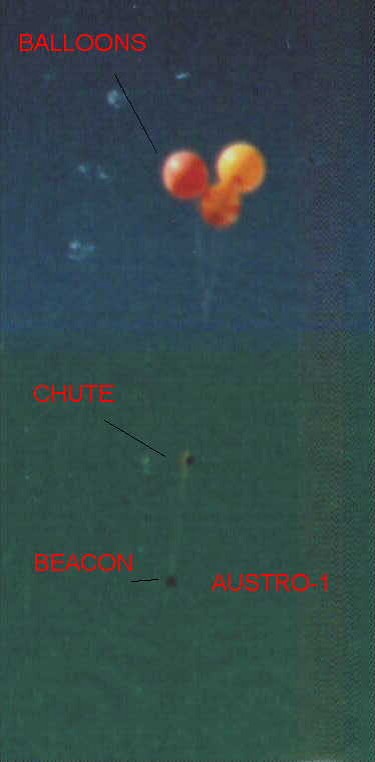AUSTRO-2, second balloon cluster launched. It consist in two balloons and was launched again from Guernica on Setember of 1991. The "AUSTRO-2" consist in three homebrew beacons on HF, 10 meter; VHF, 2 meter and UHF, 70 cm. The payload was made by LU7JCN,LU9DOG,LU3EMK and LW2DTZ. We used the same codestore that in the last flight for sent a large message in the three bands, very interesting experience of propagation were made. The total flight has a duration of 3 hours, and near 50 hams made participant in the event.The payload was lost in the Rio de la Plata.
PAMPERO-2, was launched from the campus of La Plata Engineering University in La Plata, near 30 miles southeast of Buenos Aires. The payload soported a 2m FM transmitter a CW ID tone and a light sensor mounted over the +Z face of the box. The light sensor sent a tone during the flight for determine the attitude of the balloon.Very interesting was listened when the balloon exploded and started fall to ground. The telemetry of two tones transmitted after the CW ID. The first tone reported the battery voltage with a duration of 5 seconds, and used a calibration equation:
V = (F*5.09*10^-3+1.503)
where
V = volts.
F = frequency in Hertz.
The second tone, with a 10 second duration, corresponded to the attitude sensor of the payload. The frequency of this tone corresponded to the angle formed between the payload and the sun.
A complete sequence was as follows:
The FM tone CW ID was LU7JCN/B. An operations net was held on 145.700 MHz and 7.143 MHz, +/-QRM during the balloon flight.
The 250 mW transmitter was heard for more than 500 KM (310 Mi) away and the estimated maximum altitude reached was 25 KM (75,000 Ft).
The ascending velocity was 300 Meters/minute (1000 Ft/min) and the winds moved the balloon to the East/Northeast. Stations from Santa Fe, Entre Rios, Buenos Aires, and Uruguay reported copying the balloon's beacon signals.
At 02:30 hours after launch, there were violent frequency changes in the attitude sensor, indicating the balloon's explosion and the free-fall of the payload. The free-fall continued for 30 minutes, while the beacon's signals grew stronger on Uruguay's coast.
PAMPERO-3,(LU7JCN), this was the first cross band FM repeater launch.The original designed has two tone telemetry that send inside temperature and battery voltage.Some difficults determine take out the telemetry module.The repeater was a 2m FM transmitter for the downlink and 10m FM receiver for the uplink. During the flight, and possible to very cold temperature the transmitter turn off, and the we lost it about 90 minutes of the lift off from the campus of La Plata Engineering University.
PAMPERO-4 and 5,(Hugo Lorente, LU4DXT, & LU7JCN) the same as the number three, but with a more resistence box, to the strong cold. Hams of Argentina and Uruguay can logged through the repeater as much more 600 miles.The payload was lost over the Rio de La Plata.
CORDOBA-1,(Catholic University of Cordoba,LU9HXV), this was the first lift off of a amateur balloon from this side of the country, Cordoba, that has terrain around and feel like Colorado state. The payload was constructed by students from the University, in base a meteorological radiosonde. The telemetry downlink in/out side temperature, barometric pressure and humidity using audio tones via a 2m FM transmitter. The payload was lost.
Nets.
During the flights We used either a frecuency in 40m band and 2m band for our launch information net.Very interesting to listen reports far of the launch site reporting balloon signals.



